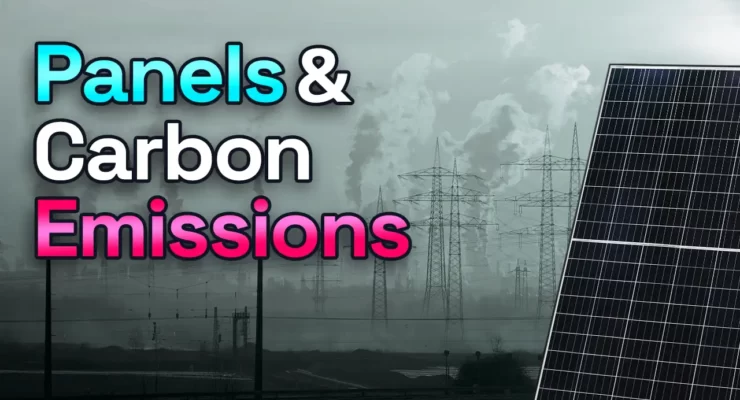Fast read
The carbon footprint of solar panels has been a topic of debate, but a thorough examination clarifies their environmental impact. Solar panels produce no carbon emissions during operation, and their manufacturing emissions are significantly lower than fossil fuels.
The carbon equivalent of solar panel generation averages less than 40 g CO2/kWh. Solar panels are becoming more eco-friendly. Manufacturing improvements are expected to reduce the energy payback period to less than 12 months.
They outperform fossil fuels like coal and gas, which have over 20 and 10 times higher carbon footprints, respectively. Solar panels play a vital role in reducing greenhouse gas emissions and advancing sustainability.
Do Solar Panels Release Carbon Dioxide?
Let’s take a deeper look at how solar panels and carbon dioxide affect the environment compared to fossil fuels.
First, let’s discuss making solar panels. Yes, it takes energy and materials, but studies show it’s much less than what’s needed for fossil fuels. As technology improves, making panels gets cleaner and more energy efficient.
Once solar panels are up and running, they’re clean machines. Unlike fossil fuel plants that pump out pollution, solar panels quietly turn sunlight into electricity without any emissions. And they keep doing it for decades, offsetting the pollution we’d get from fossil fuels.
But solar panels don’t just help the environment by producing clean power. They also reduce our reliance on fossil fuels, which is important for the planet and for communities. Plus, they create jobs in renewable energy, boosting local economies.
And when solar panels reach the end of their life, they can often be recycled, reducing waste and preserving resources.
So, while making and using solar panels isn’t completely without impact, their overall benefits for the environment are huge. They’re a vital part of fighting climate change and building a cleaner, greener future.
Solar panels and carbon dioxide emissions
Solar panels produce electricity using sunlight without emitting carbon. They do not need moving parts or fuel. But to understand their full environmental impact, we need to look at their whole lifecycle.
This includes getting the materials, making them, using them, and dealing with them when they’re done. Even though they’re clean when working, making solar panels involves using energy and creating emissions. However, improvements in manufacturing and recycling are reducing these effects.
Considering the entire lifespan of solar panels helps us see their real environmental importance. While they’re great for producing clean energy, we need to address the environmental impacts of making and getting rid of them.
The world is moving towards clean energy. It is important to make solar panels more sustainable. This will reduce their environmental impact throughout their lifecycle.
Manufacturing process
Carbon emissions are associated with the manufacturing of solar panels. Various processes, including mining raw materials, manufacturing components, and assembling solar panels, contribute to their initial carbon footprint. It’s important to know that manufacturing creates less emissions than fossil fuels.
Solar panels ‘ lifecycle assessments and energy footprints consistently demonstrate their superiority over fossil fuels. On average, the carbon equivalent of solar panel generation is less than 40 grams of CO2 per kilowatt-hour (g CO2/kWh). This comprehensive measure factors in every stage, from raw material extraction to end-of-life considerations.
Over the next 5 to 10 years, experts anticipate a 30% reduction in the lifecycle CO2 cost of solar panels as manufacturing efficiency improves. This is a promising trajectory toward even more eco-friendly solar energy production.

Energy payback period
The energy payback period is a key measure used to understand how quickly solar panels can balance out the energy used in making them. Currently, it takes about 1.5 years on average, however, this time frame is expected to decrease to less than a year soon. This improvement is because of advancements in manufacturing processes.
Why does this matter? Because it tells us that over their lifetime – which can exceed 25 years, sometimes even up to 30 years with warranties – solar panels can save way more emissions than what it took to make them. Studies show they can cut emissions by more than 20 times compared to their initial carbon cost.
This shows how effective solar panels are in fighting climate change and moving towards cleaner energy. Solar panels are getting better with technology.
They are becoming more efficient. They are also becoming more important in our efforts to reduce carbon emissions. We are transitioning to cleaner energy sources.
Compared to fossil fuels
To provide a clear perspective, let’s compare the carbon footprint of solar panels to that of fossil fuels:
Coal
Coal-fired power plants produce a lot of carbon dioxide when making electricity—around 820 grams for every kilowatt-hour. That’s over 20 times more than what solar power produces. Solar power, on the other hand, is super clean, it uses sunlight to make electricity without polluting the air.
Choosing solar energy over coal helps fight climate change and keeps the air clean. It also creates jobs and helps our economy grow. By switching to solar power and other clean energy sources, we can make a significant impact for our planet and our future.
Combined Cycle Gas
Natural gas power is cleaner than coal. However, it still emits a lot of carbon, it emits about 490 grams of CO2 per kilowatt-hour (g CO2/kWh). This is over ten times higher than solar panels.
This significant disparity shows why we should focus more on solar energy. Solar panels have a super low carbon footprint, with emissions averaging less than 50 g CO2/kWh. This means they’re one of the cleanest energy sources around. Switching to solar power and other renewables can help us reduce carbon emissions and make the planet healthier for everyone.
Future Prospects and Sustainability:
Looking ahead, the future of solar energy appears promising. As manufacturing efficiency improves and technology advances, the lifecycle carbon cost of solar panels is expected to decrease further. Moreover, ongoing research and development efforts are driving innovations in solar technology and manufacturing processes, contributing to a more sustainable energy future.
In summary, solar panels emerge as an environmentally superior source of electricity when considering their entire lifecycle. Their carbon emissions, particularly during operation, are significantly lower than those of fossil fuels, such as coal and gas. Solar panels are a key contributor to reducing greenhouse gas emissions and combating climate change.
The debate about the carbon footprint of solar panels compared to fossil fuels has been ongoing, but a thorough examination reveals that solar panels are an eco-friendly energy source. Their manufacturing emissions are significantly lower than the carbon emissions produced by fossil fuels. As efficiency gains continue in manufacturing, the energy payback period for solar panels is expected to reduce further, amplifying their environmental benefits. Solar panels are a beacon of clean energy, significantly reducing greenhouse gas emissions and promoting a sustainable future.



